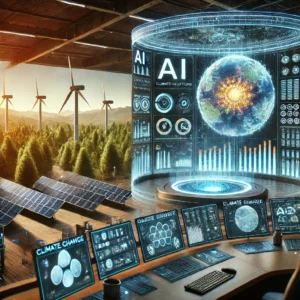How AI is Helping Solve Climate Change Challenges

How AI is Helping Solve Climate Change Challenges
Discover how AI is helping solve climate change challenges through innovative solutions like renewable energy optimization, climate modeling, and deforestation monitoring.
Climate change is one of the most pressing global issues of our time, demanding innovative solutions to mitigate its effects and protect our planet. Artificial Intelligence (AI) has emerged as a powerful tool in combating climate change by analyzing complex data, optimizing renewable energy use, and predicting environmental changes. In this article, we explore how AI is helping tackle climate change challenges and its transformative potential for a sustainable future.
—
Understanding the Role of AI in Climate Change
Artificial Intelligence leverages advanced algorithms to analyze massive datasets, identify patterns, and propose actionable solutions. Its applications range from climate modeling to enhancing renewable energy efficiency and monitoring deforestation. With AI’s ability to process information faster and more accurately than traditional methods, it is a game-changer in addressing climate change.
—
Key Areas Where AI is Impacting Climate Change
1. Climate Modeling and Prediction
AI-powered systems can analyze historical climate data and simulate future scenarios with precision. These models help:
Predict extreme weather events such as hurricanes and droughts.
Understand the impact of human activities on climate patterns.
Develop targeted climate adaptation strategies.
2. Enhancing Renewable Energy Efficiency
AI optimizes renewable energy generation and distribution by:
Predicting energy demand and supply fluctuations.
Managing smart grids for efficient energy distribution.
Enhancing the performance of solar panels and wind turbines through predictive maintenance.
3. Carbon Emissions Tracking
AI tools help monitor and reduce carbon emissions by:
Analyzing industrial activities and identifying inefficiencies.
Providing real-time data on carbon footprints for companies and individuals.
Supporting carbon capture and storage technologies.
4. Deforestation Monitoring
AI-powered satellite imagery detects deforestation activities in real-time, enabling:
Governments to take immediate action against illegal logging.
Conservationists to track forest health and biodiversity loss.
Sustainable land-use planning to minimize environmental impact.
5. Agricultural Sustainability
AI aids in sustainable farming practices by:
Predicting optimal planting and harvesting times based on weather patterns.
Minimizing water and fertilizer usage.
Improving crop yield while reducing greenhouse gas emissions.
6. Ocean Health Monitoring
AI technologies track changes in ocean temperatures, acidity levels, and biodiversity, helping:
Address issues like coral bleaching and overfishing.
Develop marine conservation strategies.
Predict and mitigate the effects of rising sea levels.
READ ALSO: What is LiDAR Technology and How It’s Changing Mapping.
—
Success Stories of AI in Combating Climate Change
1. Google’s AI for Environmental Sustainability
Google uses machine learning to improve the energy efficiency of its data centers, reducing energy usage by 40%. Their AI-powered tools also help in tracking and reducing global deforestation.
2. DeepMind’s Wind Energy Forecasting
DeepMind, an AI subsidiary of Alphabet, developed algorithms to predict wind energy output 36 hours in advance. This improves the efficiency and reliability of wind energy integration into power grids.
3. Microsoft’s AI for Earth
Microsoft’s AI for Earth program supports projects that utilize AI to solve environmental challenges, including precision agriculture, water management, and biodiversity conservation.
—
Challenges of Using AI for Climate Change
While AI holds great promise, it also faces challenges:
1. High Energy Consumption: Training AI models requires significant computational power, contributing to carbon emissions.
2. Data Accessibility: Limited access to high-quality data can hinder AI’s effectiveness.
3. Cost: Implementing AI solutions can be expensive for developing nations.
4. Ethical Concerns: Ensuring transparency and fairness in AI-driven decisions is crucial.
—
The Future of AI in Climate Change Mitigation
As AI technology advances, its potential to address climate change challenges will grow. Emerging trends include:
AI-Driven Carbon Markets: Facilitating transparent and efficient carbon trading.
Personalized Climate Action Plans: Helping individuals and organizations reduce their carbon footprint through AI recommendations.
AI-Powered Urban Planning: Designing smart cities with reduced environmental impact.
Collaboration between governments, private sectors, and research institutions will be critical to scaling AI’s impact on climate change.
—
Conclusion
Artificial Intelligence offers innovative solutions to combat the multifaceted challenges of climate change. From improving renewable energy efficiency to monitoring environmental health, AI’s applications are diverse and impactful. By integrating AI into climate strategies, we can accelerate progress towards a sustainable and resilient future.





